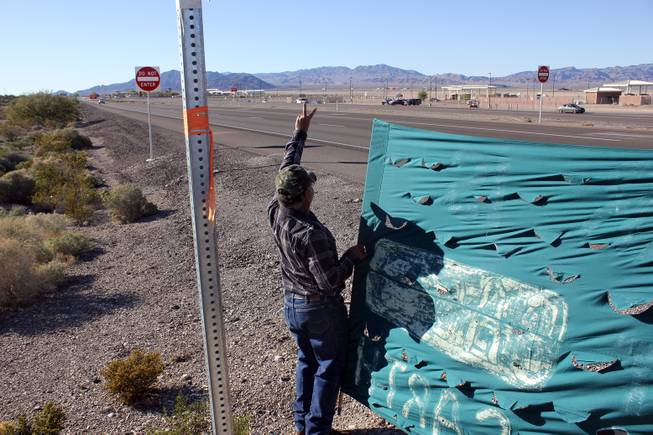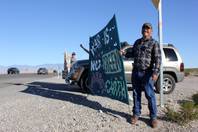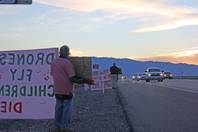Sunday, December 20, 2015
Wednesday, October 28, 2015
Demonstration at Creech Air Base in Utah
 |
| Ann Wright posted these photos of a Code Pink Demonstration. |
From Ann Wright: "Some fascinating comments from local residents about our protests at Creech drone base- not all negative!!!!
"At the Oasis Bar, the only bar in town, a resident said he didn't believe protesters would effect any change at the base level, but that he shared a concern about civilian casualties from drone strikes.
“'We do worry,' he said of the base's Reapers and Predators, the two types of drones flown from Creech. 'It was a lot better when it was a Thunderbird (flying).'
"He added that if authorities arrested protesters, they should also prosecute those responsible for civilian deaths. (Yes!!! Ann's comment)
"But even as he identified common ground with some of the protesters, he recognized the economic benefits of having the base there.
"Some Indian Springs residents said protesters should direct their message to decision-makers instead of urging drone operators to disobey commands.
"Another resident said the town had become accustomed to protests but felt they created tension among residents and lowered the morale of drone operators, which she felt was unfair because the pilots merely follow orders."

DANIEL ROTHBERG / LAS VEGAS SUN
Ruben Beltran of Indian Springs waves a peace sign during a protest Monday, Oct. 26, 2015, at Creech Air Force Base. Beltran said most Indian Springs residents dislike activists because the base hires civilians from town.
By Daniel Rothberg (contact)
Tuesday, Oct. 27, 2015 | 2 a.m.
INDIAN SPRINGS — Ruben Beltran pointed across U.S. 95 to his neighbor, a man sitting on a motorcycle inside the fenced boundary of Creech Air Force Base.
Beltran and the man on the motorcycle know each other, like a good many other residents of this community of about 1,000 people. But they don't know each other in the warm small-town way captured in Norman Rockwell paintings.
“That guy, he hates me," Beltran said.
What divides Beltran and his neighbor is something that also has created fault lines among Americans well beyond Indian Springs. It's drone warfare. Beltran is an outspoken anti-drone activist, an anomaly for a resident of Indian Springs. On Monday afternoon, he was standing at a weeklong anti-drone protest directed at the pilots and civilian staff who commute every day to Creech, one of the military’s hubs for flying drones.
“They don't like people like us here because a lot of people work at the base," he said.
In fact, Beltran said that the town’s connection to the base runs so deep that some of his neighbors who work at the base no longer talk to him because of his activism.
While the installation has been in this small town for several decades, its purpose has shifted over the years, from being a practice site of the Thunderbirds precision flight team to being the base of operations for drones used for 24/7 surveillance or strikes overseas.
As a result, the town has been a magnet for anti-war protesters like Beltran. This week, Code Pink, the grass-roots group known for disrupting congressional hearings and political speeches, is expected to protest on the highway by Creech twice a day until Friday. With the town in the spotlight, many residents said they had a dim view of the activists.
Several residents said they supported the base, which provides jobs to the community. And even those who are more sympathetic with an anti-drone sentiment believe protesting at the base is futile in affecting change and see the importance of having the base.
“They feed so many families,” said a resident who used to work as a civilian at Creech.
Accordingly, conversations with residents reveal how sensitive the topic of Creech is in the town. Residents were not willing to be identified because some worked at the base, had plans to apply for a job there or believed speaking about the base could harm their businesses.
Indian Springs, an unincorporated town in Clark County, has always had strong ties to the military. Besides being the home of Creech, it’s adjacent to a 2.9 million-acre test range and is 45 miles away from the Nevada National Security Site. As such, the military has served as one of the town’s principal employers and is integral to keeping the economy afloat.
But the drone missions have brought new attention to the town. Code Pink members have traveled to Creech since 2009 to call for an end to drone strikes, which in their view have been responsible for more civilian deaths than the government has acknowledged and have helped galvanize the nation's enemies. Other groups have come as well. Dozens of peace activists were arrested in March for trespassing and blocking the base.
Some residents said the protests had become business as usual. Asked about Code Pink’s peaceful 15-person rally Monday morning, a former employee of the town’s shuttered casino responded in an unsurprised tone: “There’s another protest?”
At times, though, several residents said the protesters had triggered a backlash. Residents have been known to stage counterprotests at Creech. One resident, who works full-time at the base as a civilian contractor and whose father worked at the Nevada National Security Site, said the counterprotesters felt the activists shed a negative light on the town, a sentiment echoed by several other residents.
“I used to flip them off every time I passed,” said the former Creech contractor. “They’re not always peaceful.”
She said the town had become accustomed to protests but felt they created tension among residents and lowered the morale of drone operators, which she felt was unfair because the pilots merely follow orders.
On Monday, protesters arrived at 6 a.m. so they could catch the attention of pilots on their commute. Some Indian Springs residents said protesters should direct their message to decision-makers instead of urging drone operators to disobey commands.
At the Oasis Bar, the only bar in town, a resident said he didn't believe protesters would effect any change at the base level, but that he shared a concern about civilian casualties from drone strikes.
“We do worry,” he said of the base's Reapers and Predators, the two types of drones flown from Creech. “It was a lot better when it was a Thunderbird (flying).”
He added that if authorities arrested protesters, they should also prosecute those responsible for civilian deaths. But even as he identified common ground with some of the protesters, he recognized the economic benefits of having the base there.
He said he might even apply for a job there.
Labels:
Afghanistan,
Ann Wright,
Bombs,
Code Pink,
Creech Air Base,
Drones,
iraq,
Libya,
Medea Benjamin,
mothers,
Pakistan,
Somalia,
Utah,
war dead,
war resisters,
Women,
Yemen
Monday, October 19, 2015
Vera Williams, Grace’s friend and collaborator has passed away
Subscribe to:
Comments (Atom)















